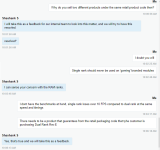I guess it depends on budget and what you are willing to spend just as much as requirements. You could tell someone not to buy a Ferrari as most of the time they won't go over 30mph. It's human nature to default to getting as much as you can for your purchase even if you don't use it all.
If its a case of purely being practical then why buy loads of RGB stuff to light up a box? It serves no functional purpose other than making the components glow in the dark.
I do have a limit though as to how much "excess requirement" I will go to but again it depends on price and % of the overall build cost. If I spend for example £2K on a new PC and it will cost £300 for 32GB, £400 for 64GB and £500 for 128GB. If I budgeted £350 for 32Gb but an extra £50 is going to double my RAM, in the
grand scheme of things, I may think it is worth it to me. I may have budgeted £600 for RAM, or even spent less on other components than anticipated, in which case I might say that I may not use 128GB but it falls inside what I have allocated.
If its a case of purely being practical then why buy loads of RGB stuff to light up a box? It serves no functional purpose other than making the components glow in the dark.
I do have a limit though as to how much "excess requirement" I will go to but again it depends on price and % of the overall build cost. If I spend for example £2K on a new PC and it will cost £300 for 32GB, £400 for 64GB and £500 for 128GB. If I budgeted £350 for 32Gb but an extra £50 is going to double my RAM, in the
grand scheme of things, I may think it is worth it to me. I may have budgeted £600 for RAM, or even spent less on other components than anticipated, in which case I might say that I may not use 128GB but it falls inside what I have allocated.



